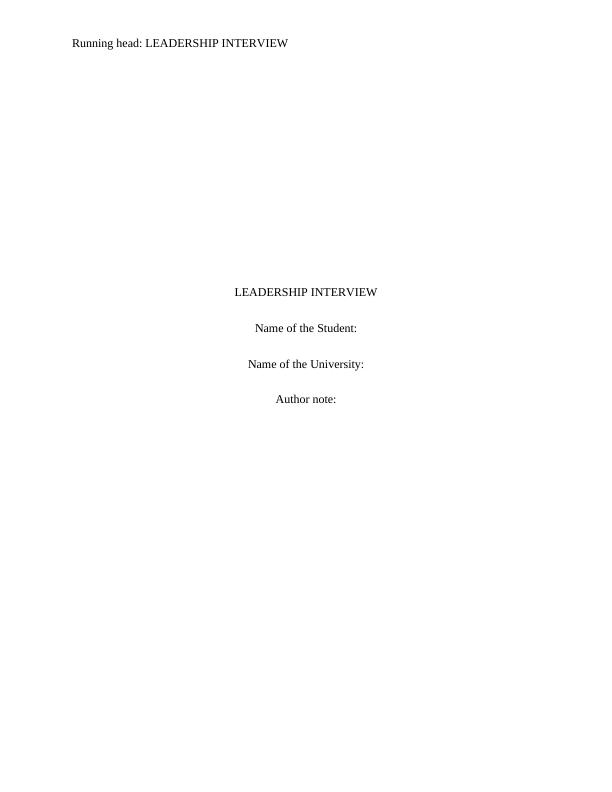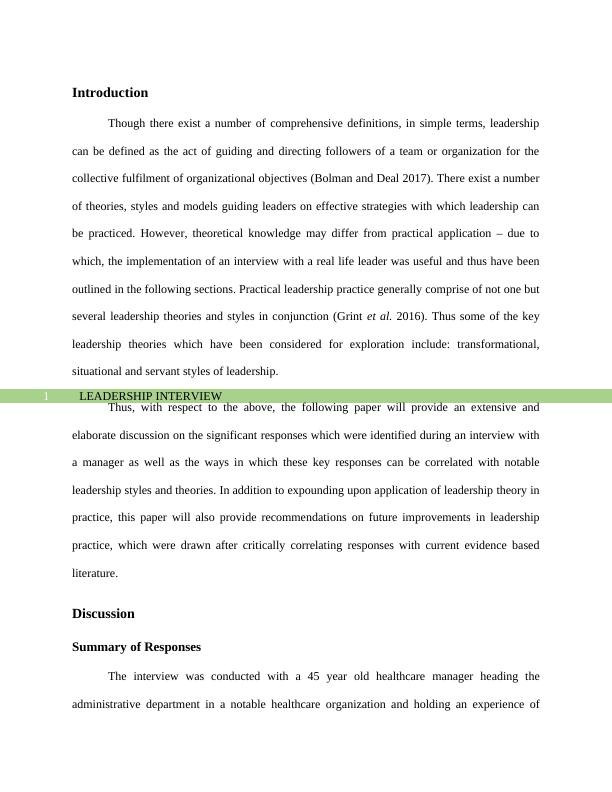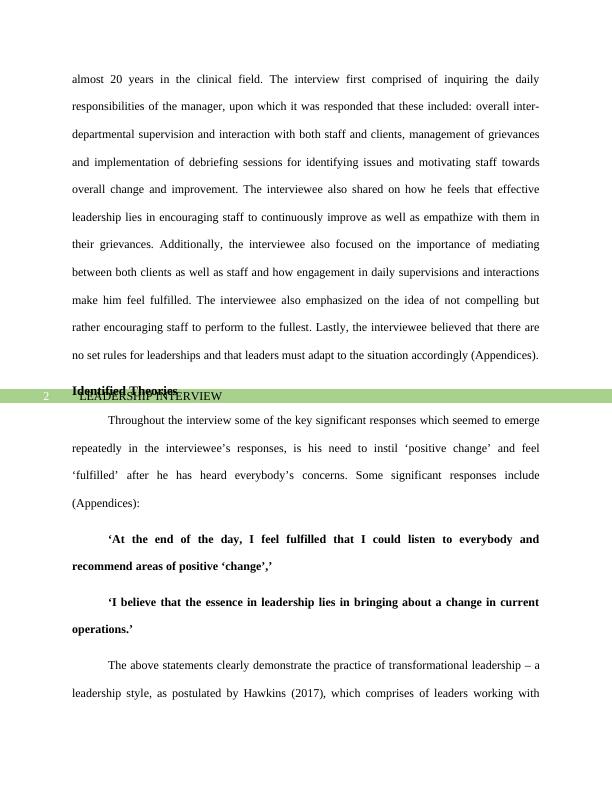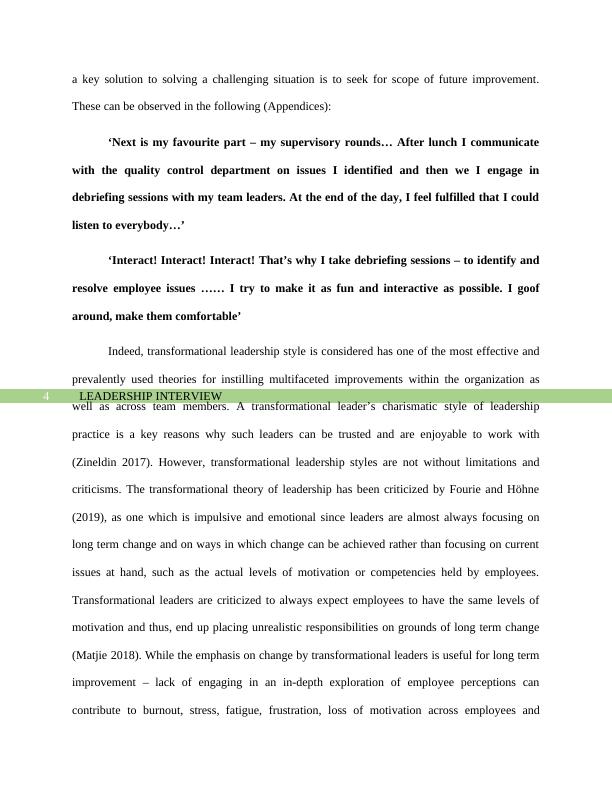Transformational Leadership Styles
Added on 2022-09-13
21 Pages5573 Words14 Views
Running head: LEADERSHIP INTERVIEW
LEADERSHIP INTERVIEW
Name of the Student:
Name of the University:
Author note:
LEADERSHIP INTERVIEW
Name of the Student:
Name of the University:
Author note:

LEADERSHIP INTERVIEW1
Introduction
Though there exist a number of comprehensive definitions, in simple terms, leadership
can be defined as the act of guiding and directing followers of a team or organization for the
collective fulfilment of organizational objectives (Bolman and Deal 2017). There exist a number
of theories, styles and models guiding leaders on effective strategies with which leadership can
be practiced. However, theoretical knowledge may differ from practical application – due to
which, the implementation of an interview with a real life leader was useful and thus have been
outlined in the following sections. Practical leadership practice generally comprise of not one but
several leadership theories and styles in conjunction (Grint et al. 2016). Thus some of the key
leadership theories which have been considered for exploration include: transformational,
situational and servant styles of leadership.
Thus, with respect to the above, the following paper will provide an extensive and
elaborate discussion on the significant responses which were identified during an interview with
a manager as well as the ways in which these key responses can be correlated with notable
leadership styles and theories. In addition to expounding upon application of leadership theory in
practice, this paper will also provide recommendations on future improvements in leadership
practice, which were drawn after critically correlating responses with current evidence based
literature.
Discussion
Summary of Responses
The interview was conducted with a 45 year old healthcare manager heading the
administrative department in a notable healthcare organization and holding an experience of
Introduction
Though there exist a number of comprehensive definitions, in simple terms, leadership
can be defined as the act of guiding and directing followers of a team or organization for the
collective fulfilment of organizational objectives (Bolman and Deal 2017). There exist a number
of theories, styles and models guiding leaders on effective strategies with which leadership can
be practiced. However, theoretical knowledge may differ from practical application – due to
which, the implementation of an interview with a real life leader was useful and thus have been
outlined in the following sections. Practical leadership practice generally comprise of not one but
several leadership theories and styles in conjunction (Grint et al. 2016). Thus some of the key
leadership theories which have been considered for exploration include: transformational,
situational and servant styles of leadership.
Thus, with respect to the above, the following paper will provide an extensive and
elaborate discussion on the significant responses which were identified during an interview with
a manager as well as the ways in which these key responses can be correlated with notable
leadership styles and theories. In addition to expounding upon application of leadership theory in
practice, this paper will also provide recommendations on future improvements in leadership
practice, which were drawn after critically correlating responses with current evidence based
literature.
Discussion
Summary of Responses
The interview was conducted with a 45 year old healthcare manager heading the
administrative department in a notable healthcare organization and holding an experience of

LEADERSHIP INTERVIEW2
almost 20 years in the clinical field. The interview first comprised of inquiring the daily
responsibilities of the manager, upon which it was responded that these included: overall inter-
departmental supervision and interaction with both staff and clients, management of grievances
and implementation of debriefing sessions for identifying issues and motivating staff towards
overall change and improvement. The interviewee also shared on how he feels that effective
leadership lies in encouraging staff to continuously improve as well as empathize with them in
their grievances. Additionally, the interviewee also focused on the importance of mediating
between both clients as well as staff and how engagement in daily supervisions and interactions
make him feel fulfilled. The interviewee also emphasized on the idea of not compelling but
rather encouraging staff to perform to the fullest. Lastly, the interviewee believed that there are
no set rules for leaderships and that leaders must adapt to the situation accordingly (Appendices).
Identified Theories
Throughout the interview some of the key significant responses which seemed to emerge
repeatedly in the interviewee’s responses, is his need to instil ‘positive change’ and feel
‘fulfilled’ after he has heard everybody’s concerns. Some significant responses include
(Appendices):
‘At the end of the day, I feel fulfilled that I could listen to everybody and
recommend areas of positive ‘change’,’
‘I believe that the essence in leadership lies in bringing about a change in current
operations.’
The above statements clearly demonstrate the practice of transformational leadership – a
leadership style, as postulated by Hawkins (2017), which comprises of leaders working with
almost 20 years in the clinical field. The interview first comprised of inquiring the daily
responsibilities of the manager, upon which it was responded that these included: overall inter-
departmental supervision and interaction with both staff and clients, management of grievances
and implementation of debriefing sessions for identifying issues and motivating staff towards
overall change and improvement. The interviewee also shared on how he feels that effective
leadership lies in encouraging staff to continuously improve as well as empathize with them in
their grievances. Additionally, the interviewee also focused on the importance of mediating
between both clients as well as staff and how engagement in daily supervisions and interactions
make him feel fulfilled. The interviewee also emphasized on the idea of not compelling but
rather encouraging staff to perform to the fullest. Lastly, the interviewee believed that there are
no set rules for leaderships and that leaders must adapt to the situation accordingly (Appendices).
Identified Theories
Throughout the interview some of the key significant responses which seemed to emerge
repeatedly in the interviewee’s responses, is his need to instil ‘positive change’ and feel
‘fulfilled’ after he has heard everybody’s concerns. Some significant responses include
(Appendices):
‘At the end of the day, I feel fulfilled that I could listen to everybody and
recommend areas of positive ‘change’,’
‘I believe that the essence in leadership lies in bringing about a change in current
operations.’
The above statements clearly demonstrate the practice of transformational leadership – a
leadership style, as postulated by Hawkins (2017), which comprises of leaders working with

LEADERSHIP INTERVIEW3
collectively with team members for the purpose of identifying changes and improvement areas as
well as inspiring followers to develop and adhere to a vision for professional, organizational and
most importantly personal change. The need to encourage positive change across the
organization as well as by the team members themselves can be observed in the interviewee’s
following statements (Appendices):
‘I encourage staff to share what they think must be improved – both within their
own practice as well as the organization.’
Indeed, it has been evidenced by Banks et al. (2016), that the need to outline key
organizational priorities and encouraging employees to practice self-reflection beyond personal
interests are prevalent aspects of transformational leadership theory to practice – as heavily
observed in the interview. Such practice aspects can further be collectively categorized under the
characteristic of ‘extraversion’ - a key trait in this leadership style, comprising of
transformational leaders feeling the need to be affiliated or ‘involved’ or ‘belonging’ to the daily
staff activities of the organization, and is a way by which transformational leaders seek to listen
to team concerns, demonstrate motivation and project themselves as someone to be trustworthy
and inspirational (Lanaj, Johnson and Lee 2016). Such leadership practices, as evidenced by
Koveshnikov and Ehrnrooth (2018), are collectively termed as the characteristic principle of
‘idealized influence’ in transformational leadership, that is, the practice of ‘walking the talk’ or
setting an influence or example to their team members. The above application of
transformational leadership theories to practice can be observed extensively in the interviewee’s
responses where he claims to feel fulfilled after engaging in his favorite daily supervision
rounds, his attempts of making daily debriefing session and enjoyable practice and his belief that
collectively with team members for the purpose of identifying changes and improvement areas as
well as inspiring followers to develop and adhere to a vision for professional, organizational and
most importantly personal change. The need to encourage positive change across the
organization as well as by the team members themselves can be observed in the interviewee’s
following statements (Appendices):
‘I encourage staff to share what they think must be improved – both within their
own practice as well as the organization.’
Indeed, it has been evidenced by Banks et al. (2016), that the need to outline key
organizational priorities and encouraging employees to practice self-reflection beyond personal
interests are prevalent aspects of transformational leadership theory to practice – as heavily
observed in the interview. Such practice aspects can further be collectively categorized under the
characteristic of ‘extraversion’ - a key trait in this leadership style, comprising of
transformational leaders feeling the need to be affiliated or ‘involved’ or ‘belonging’ to the daily
staff activities of the organization, and is a way by which transformational leaders seek to listen
to team concerns, demonstrate motivation and project themselves as someone to be trustworthy
and inspirational (Lanaj, Johnson and Lee 2016). Such leadership practices, as evidenced by
Koveshnikov and Ehrnrooth (2018), are collectively termed as the characteristic principle of
‘idealized influence’ in transformational leadership, that is, the practice of ‘walking the talk’ or
setting an influence or example to their team members. The above application of
transformational leadership theories to practice can be observed extensively in the interviewee’s
responses where he claims to feel fulfilled after engaging in his favorite daily supervision
rounds, his attempts of making daily debriefing session and enjoyable practice and his belief that

LEADERSHIP INTERVIEW4
a key solution to solving a challenging situation is to seek for scope of future improvement.
These can be observed in the following (Appendices):
‘Next is my favourite part – my supervisory rounds... After lunch I communicate
with the quality control department on issues I identified and then we I engage in
debriefing sessions with my team leaders. At the end of the day, I feel fulfilled that I could
listen to everybody...’
‘Interact! Interact! Interact! That’s why I take debriefing sessions – to identify and
resolve employee issues ...... I try to make it as fun and interactive as possible. I goof
around, make them comfortable’
Indeed, transformational leadership style is considered has one of the most effective and
prevalently used theories for instilling multifaceted improvements within the organization as
well as across team members. A transformational leader’s charismatic style of leadership
practice is a key reasons why such leaders can be trusted and are enjoyable to work with
(Zineldin 2017). However, transformational leadership styles are not without limitations and
criticisms. The transformational theory of leadership has been criticized by Fourie and Höhne
(2019), as one which is impulsive and emotional since leaders are almost always focusing on
long term change and on ways in which change can be achieved rather than focusing on current
issues at hand, such as the actual levels of motivation or competencies held by employees.
Transformational leaders are criticized to always expect employees to have the same levels of
motivation and thus, end up placing unrealistic responsibilities on grounds of long term change
(Matjie 2018). While the emphasis on change by transformational leaders is useful for long term
improvement – lack of engaging in an in-depth exploration of employee perceptions can
contribute to burnout, stress, fatigue, frustration, loss of motivation across employees and
a key solution to solving a challenging situation is to seek for scope of future improvement.
These can be observed in the following (Appendices):
‘Next is my favourite part – my supervisory rounds... After lunch I communicate
with the quality control department on issues I identified and then we I engage in
debriefing sessions with my team leaders. At the end of the day, I feel fulfilled that I could
listen to everybody...’
‘Interact! Interact! Interact! That’s why I take debriefing sessions – to identify and
resolve employee issues ...... I try to make it as fun and interactive as possible. I goof
around, make them comfortable’
Indeed, transformational leadership style is considered has one of the most effective and
prevalently used theories for instilling multifaceted improvements within the organization as
well as across team members. A transformational leader’s charismatic style of leadership
practice is a key reasons why such leaders can be trusted and are enjoyable to work with
(Zineldin 2017). However, transformational leadership styles are not without limitations and
criticisms. The transformational theory of leadership has been criticized by Fourie and Höhne
(2019), as one which is impulsive and emotional since leaders are almost always focusing on
long term change and on ways in which change can be achieved rather than focusing on current
issues at hand, such as the actual levels of motivation or competencies held by employees.
Transformational leaders are criticized to always expect employees to have the same levels of
motivation and thus, end up placing unrealistic responsibilities on grounds of long term change
(Matjie 2018). While the emphasis on change by transformational leaders is useful for long term
improvement – lack of engaging in an in-depth exploration of employee perceptions can
contribute to burnout, stress, fatigue, frustration, loss of motivation across employees and

LEADERSHIP INTERVIEW5
misperceptions where employees feel that they are being taken advantage of (Ghasabeh and
Provitera 2017).
However, it has been recommended by Martínez-Córcoles, Stephanou and Schöbel
(2020), that a key way by which transformational leaders can address the above critical aspects
of this leadership style is via the practice of the principle of ‘Individualized Consideration’. As
per the principle of ‘Individualized Consideration’ transformational leaders empathize with the
problems, concerns and issues faced by the employees and staff members, identify the
underlying causative factors of such problems, collaboratively communicate the same to the
employee and encourage them to work towards resolution of the issue (Jin, Seo and Shapiro
2016). The practice of individualized consideration is especially important in transformational
leadership due to multifaceted reasons. Not only does this principle instil positive perceptions
where employees feel that they are being respected and empathized with, but it also encourages
the leader to keep a check on potential grievances of employees and how the same can be
corrected for future long term improvement (Phaneuf et al. 2016). Indeed, the practice of
individualized consideration can be observed in the interview where the interviewee shares a key
personal experience, as enlisted below (Appendices):
‘A few years back, one of my team leaders was reported to perform poorly at
work.... I found about regarding the recent death of her husband. I empathized,
complemented her for her efforts and gave her a few days off. And voila! She was back
better than ever!’
In addition to transformational style of leadership, a close examination of responses from
the interview demonstrate the application of a situational style of leadership by the interviewee.
To expound upon the same, the following statement from the interview is useful (Appendices):
misperceptions where employees feel that they are being taken advantage of (Ghasabeh and
Provitera 2017).
However, it has been recommended by Martínez-Córcoles, Stephanou and Schöbel
(2020), that a key way by which transformational leaders can address the above critical aspects
of this leadership style is via the practice of the principle of ‘Individualized Consideration’. As
per the principle of ‘Individualized Consideration’ transformational leaders empathize with the
problems, concerns and issues faced by the employees and staff members, identify the
underlying causative factors of such problems, collaboratively communicate the same to the
employee and encourage them to work towards resolution of the issue (Jin, Seo and Shapiro
2016). The practice of individualized consideration is especially important in transformational
leadership due to multifaceted reasons. Not only does this principle instil positive perceptions
where employees feel that they are being respected and empathized with, but it also encourages
the leader to keep a check on potential grievances of employees and how the same can be
corrected for future long term improvement (Phaneuf et al. 2016). Indeed, the practice of
individualized consideration can be observed in the interview where the interviewee shares a key
personal experience, as enlisted below (Appendices):
‘A few years back, one of my team leaders was reported to perform poorly at
work.... I found about regarding the recent death of her husband. I empathized,
complemented her for her efforts and gave her a few days off. And voila! She was back
better than ever!’
In addition to transformational style of leadership, a close examination of responses from
the interview demonstrate the application of a situational style of leadership by the interviewee.
To expound upon the same, the following statement from the interview is useful (Appendices):

End of preview
Want to access all the pages? Upload your documents or become a member.
Related Documents
An alternative approach to nurse manager leadershiplg...
|10
|2412
|14
Nursing Leadershiplg...
|5
|1186
|380
Nursing Leadership Answer 2022lg...
|4
|716
|17
Preparation and Presentation of a Leadership Development Planlg...
|20
|4634
|100
Developing Operational Management Skills for Healthcare Practicelg...
|16
|5117
|1
Nursing Leadershiplg...
|9
|2880
|94